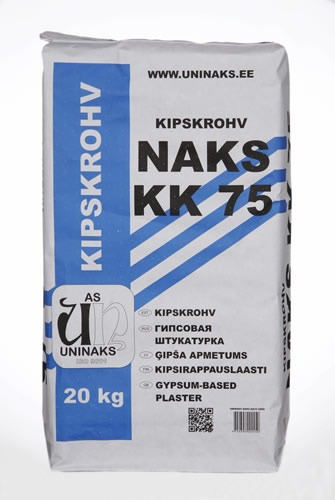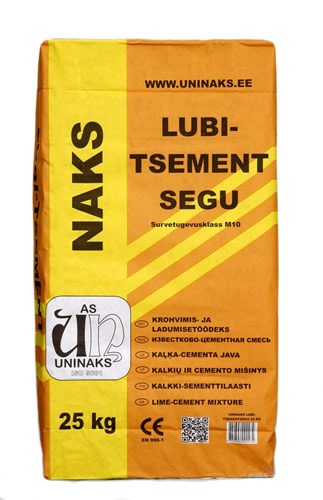Description
KIPSKROHV NAKS KK75
GYPSUM-BASED PLASTER NAKS KK 75
Light gypsum-based mineral plaster.
For plastering guns or common manual method.
For interior use.
APPLICATION
For plastering interior walls, ceilings and other building constructions.
The plaster is used in rooms with normal air humidity.
Suitable for underlying surfaces under paint and wallpaper. Also the underlying surface for tiles if the plaster is prior improved with damp course primers. (Uninaks Damp course or Water stop)
UNDERLYING SURFACE
Any kind of brick work, concrete surfaces and primarily plastered surfaces are suitable underlying surfaces. Plasterboards, fibreboards, Styrofoam boards have to be primed prior.
Underlying surfaces have to be clean and dust-free.
PREPARATIONS FOR WORK
Process surfaces with bonding primer if necessary. Let the primer dry.
When applying the plaster gun, find out the proper amount of water required in the gun first.
For manual plastering add 10-12 litres of water per one 20-kilo bag. Mix mechanically or manually until it is evenly wet. One bag gives about 25 litres of ready-made mixture, which is adequate for plastering 2.5 m2 with a 1-cm thick plaster layer.
The ready-made compound has to be flexible and must not flow.
NB! The ready-made compound has to be applied on the surface within 20 minutes.
APPLICATION OF PLASTER
The normal thickness of the plaster layer is usually 5 -15 mm. Repair of plaster is up to 50 mm. The pressure in the hose upon working with the plaster gun has to be about 1 bar/m. When using the plaster gun the plaster is applied from top towards the bottom. Pauses should not be longer than 10 minutes because the compound may settle in the equipment. The plaster on the walls is smoothed 60-90 minutes later depending on the thickness of the plaster layer. First smoothing is done by the smoother until the surface is still a little rough. Then a wet friction sponge enables to increase the smoothness of the surface. After the surface is dry it is possible to finish it with a strop.
When applying manually, deep holes and hollows have to be filled first. The plaster is applied on the wall from below upwards by using wider plastic friction devices. About 10 minutes later the plaster is levelled and smoothed with longer smoothing devices. New hollows are filled with new compound. The final smoothing of the plaster is done after 1.5 hours by a wet friction sponge, which liquidates the final unevenness.
SETTING
The average setting time is 7 days. Good ventilation enhances the drying time of the plaster.
The final setting time of the plaster depends on the humidity and water absorption of the surface, air humidity, temperature of the underlying surface and the air. Before the next levelling course is applied on the wall, the previous one has to be dry.
RESTRICTIONS
When working with plaster the air temperature and the temperature of the underlying surface has to be +50.
Sudden dropping of temperature may damage the plaster layers which are not completely dry.
STORING
Store the bags with compound powder in a dry room.
The storing time of the dry compound powder in dry conditions is 6 months.
TECHNICAL DATA
• One bag of 20 kg provides 25 litres of ready-made compound.
• One bag of 20 kg is enough for plastering about 2.5 m2, 1-cm thick plaster layer.
• Tone of the petrified plaster White (greyish shadow)
• Fire resistance class A1
• Adhesive strength weight of the underlying surface ≥ 0,5 N/mm2
• Steam permeability factor µ 10
• Thermal conductivity 0,39 W/mK
• Compression strength ≥ 3,0 N/mm2
• Volume weight after setting: ~ 1050 kg/m3




